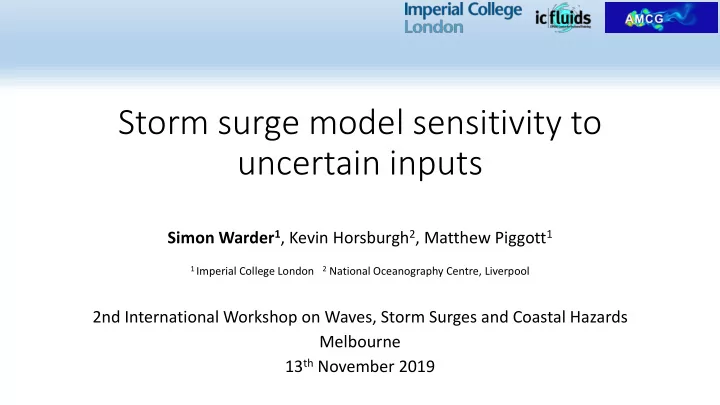

Storm surge model sensitivity to uncertain inputs Simon Warder 1 , Kevin Horsburgh 2 , Matthew Piggott 1 1 Imperial College London 2 National Oceanography Centre, Liverpool 2nd International Workshop on Waves, Storm Surges and Coastal Hazards Melbourne 13 th November 2019
Thetis coastal ocean model • Thetis : an adjoint-capable finite Thetis-2D has been used for: element coastal ocean model Tides • Implemented within Firedrake finite element framework Storm surge • Pyadjoint for adjoint code generation • P1DG-P1DG finite element pair and Tsunami Crank-Nicolson timestepper (others available) Inundation Tidal energy
Thetis model setup: North Sea
Research questions • What are the spatial and temporal patterns of storm surge model sensitivity to its uncertain inputs? • Bathymetry • Bottom friction coefficient • Wind stress • What are the similarities/differences between the sensitivities of model outputs at different locations? • Can we compare the magnitudes of sensitivity to each of these inputs?
Adjoint methods • Provide different information to ensemble-based methods • Insightful, computationally efficient • Functional 𝐾 is the peak residual at a given ‘target’ Output Model inputs Forward model 𝑛 𝐾 Sensitivity 𝜖𝐾 Adjoint model 𝜖𝑛
Sensitivity Results
Sensitivity of peak surge residual to bathymetry Lowestoft North Shields Immingham
Sensitivity of peak surge residual to bathymetry • Net influence of bathymetry is negative • Defensive property of sand bank • High sensitivity magnitudes in highly localised regions • Similar far-field sensitivity patterns • Immingham shows greatest overall (space-integrated) sensitivity • Likely due to shallow water in vicinity of Immingham Integral along coastline
Sensitivity of peak surge residual to bottom friction coefficient Lowestoft North Shields Immingham
Sensitivity of peak surge residual to bottom friction coefficient • Net influence of bottom friction coeff is negative • High sensitivity magnitudes in highly localised regions, especially in shallow water • Similar far-field sensitivity patterns • Increasing total (space-integrated) sensitivity moving south • Due to cumulative effect as surge propagates south • Implications for the use of spatially varying bottom friction coefficient Integral along coastline
Sensitivity of peak surge residual to wind stress • Wind stress is time varying; so is sensitivity • Perturbations due to wind stress travel at approximately the shallow water wave speed • Sensitivity pattern is like shallow water wave, spreading out from observation location backwards in time (Wilson et al, 2013) • This is both intuitive and simple to prove (Warder et al, 2019)
Sensitivity of peak surge residual to wind stress
Sensitivity of peak surge residual to wind stress Lowestoft North Shields Immingham
Sensitivity of peak surge residual to bathymetry • Peak surge is mostly influenced by wind stresses in 24 hours prior to peak • Immingham shows greatest sensitivity • Similar far-field sensitivity patterns, plus local effects • Errors in north of the domain propagate south with surge Integral along coastline
Comparison of sources of uncertainty • Comparison of sensitivity to each input requires estimate of input uncertainty • Use multiple datasets for bathymetry, literature for Manning coeff North Shields Immingham Lowestoft Coastline section Bathymetry (± 2.7 m) 0.047 m 0.074 m 0.035 m 0.22 m Manning coeff (± 0.005) 0.097 m 0.16 m 0.19 m 0.18 m • Uncertainty in meteorological inputs varies with lead time; typical ensemble range at 24 hour lead time is O(1m)
Conclusions • Uncertainty in surge predictions has been analysed using an adjoint surge model • Spatial patterns of sensitivity to bathymetry and bottom friction coeff show local effects, and similarity in far field • Implications for model calibration using spatially varying friction coeff • Confirms what we already know – uncertainties in meteorological forcing are most important • Adjoint-derived sensitivity is a tool for mapping input uncertainties onto surge uncertainty • And many more?
Thank you for your attention
References • Thetis coastal ocean model: discontinuous Galerkin discretization for the three-dimensional hydrostatic equations. Kärnä, T., Kramer, S. C., Mitchell, L., Ham, D. A., Piggott, M. D., and Baptista, A. M. Geosci. Model Dev., 11:4359 – 4382, https://doi.org/10.5194/gmd-11-4359-2018, 2018 • Firedrake: Automating the Finite Element Method by Composing Abstractions. Rathgeber, F.; Ham, D. A.; Mitchell, L.; Lange, M.; Luporini, F.; Mcrae, A. T. T.; Bercea, G.; Markall, G. R.; and Kelly, P. H. J. ACM Trans. Math. Softw., 43(3): 24:1 – 24:27. 2016. • Automated derivation of the adjoint of high-level transient finite element programs. Patrick E. Farrell, David A. Ham, Simon W. Funke and Marie E. Rognes. SIAM Journal on Scientific Computing 35.4, pp. C369-C393, 2013. • Efficient unstructured mesh generation for marine renewable energy applications. Alexandros Avdis, Adam S Candy, Jon Hill, Stephan C Kramer, and Matthew D Piggott. Renewable Energy, 116:842 – 856, 2018. doi:10.1016/j.renene.2017.09.058 • Tide-surge adjoint modeling: A new technique to understand forecast uncertainty. Chris Wilson, Kevin J. Horsburgh, Jane Williams, Jonathan Flowerdew, and Laure Zanna. Journal of Geophysical Research: Oceans, 118(10):5092 – 5108, 2013. • Understanding the contribution of uncertain wind stress to storm surge predictions. Simon C Warder, Kevin J Horsburgh, and Matthew D Piggott. In 4th IMA International Conference on Flood Risk, Swansea, 2019
Recommend
More recommend